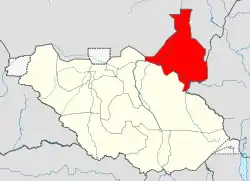Upper Nile (state)
Upper Nile is a state in South Sudan. The White Nile flowes through the state, giving it its name. The state also shares a similar name with the region of Greater Upper Nile, of which it was part along with the states of Unity and Jonglei. It had an area of 77,823 square kilometres (30,048 sq mi). Malakal was the capital of the state. The town of Kodok, the location of the Fashoda Incident that ended the "Scramble for Africa", was located in the state. Upper Nile seceded from Sudan as part of the Republic of South Sudan on 9 July 2011.
Upper Nile | |
|---|---|
 Flag | |
 Location in South Sudan. | |
| Coordinates: 09°46′N 32°44′E | |
| Country | |
| Region | Greater Upper Nile |
| Capital | Malakal |
| Government | |
| • Governor | Budhok Ayang Kur |
| Area | |
| • Total | 77,823.42 km2 (30,047.79 sq mi) |
| Population (2008 census) | |
| • Total | 964,353 |
| • Density | 12/km2 (32/sq mi) |
| Time zone | UTC+3 (EAT) |
| HDI (2018) | 0.455[1] low · 3rd of 10 |
In October 2015, the states of South Sudan were reorganized into 28 states by President Salva Kiir. This was reversed as the result of a peace agreement signed on 22 February 2020.[2]
Counties
Newspapers and television
Most Upper Nile State citizens hawe limited access to news and other media information. In cities like Malakal, only few officials could read weekly newspaper bulletins. However, the Juba based 'Citizen' is widely read around the town on a regular basis. Meanwhile, on the eve of Independence day on July 9, 2011, a digital newspaper called The Upper Nile Times was launched in Malakal to cater news stories on the State and Southern Sudan as whole. This online digital newspaper is widely read around the town of Malakal and other counties with access to the internet. The newspaper also is one of the most rated in Upper Nile State, Southern Sudan and around the world. Moreover, the only TV station for the people of Upper Nile State is South Sudan Television. Although the Station works for only few hours, it is widely popular in the state capital. Some foreign TV stations ware also broadcast in the area using portable satellite dishes.
See also
References
- "Sub-national HDI - Area Database - Global Data Lab". hdi.globaldatalab.org. Retrieved 2020-04-18.
- https://www.aljazeera.com/news/2020/02/6-years-war-peace-finally-south-sudan-200223114919537.html
- Upper Nile. UNHCR, South Sudan. Retrieved July 18, 2011